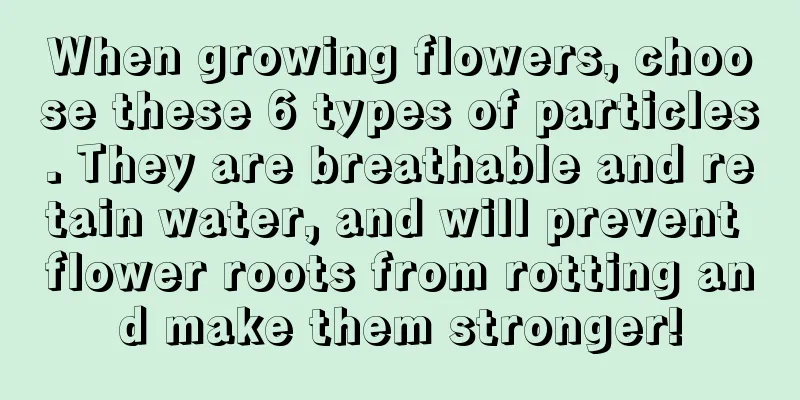When growing flowers, choose these 6 types of particles. They are breathable and retain water, and will prevent flower roots from rotting and make them stronger!

ClayExpanded clay, also known as foamed stone, is fired at high temperatures and has many small holes on its surface, which facilitate water and air permeability. We usually put expanded clay at the bottom of the pot or use it as a paving surface to absorb excess moisture and prevent root rot. If expanded clay is used to pad the bottom of the pot, just spread it on the bottom of the pot. It is usually placed in a deeper pot for paving, about 5 cm above the surface of the flower soil, leaving a distance above for easy watering. coarse sandCoarse sand, also known as river sand, is a material with very good drainage and air permeability. Generally, we will mix it with nutrient soil in a 1:1 ratio to make flower soil. Coarse sand can effectively prevent soil compaction, allow for ventilation and drainage, and prevent plant root rot. Coarse sand can be used as a culture medium for rooting of green plant cuttings, with good results. Bricks and tilesBricks and tiles also have good drainage properties, and they can also absorb excess water to prevent plant root rot. When using, you should first knock the bricks and tiles into small pieces of about 1 cm. When padding the bottom of the pot, be careful not to let it block the drainage holes. It can also be used as paving. Wood chipsSawdust has good properties of looseness, air permeability, water permeability and water retention. It also has strong heat preservation properties and is very beneficial to the growth of plant roots. Fresh wood chips must be composted before they can be mixed into the soil. Put the sawdust in a plastic bag, pour in clean water, seal it, and expose it to the sun. After 1 to 2 months, the color will turn black and the decomposition is complete. After the well-rotted sawdust is dried, it can be mixed into the soil or used as paving. Using sawdust to grow orchids can prevent the orchid's root system from rotting and help it grow stronger. charcoalThe texture of charcoal is relatively loose, which not only has strong drainage and air permeability, but also good moisturizing properties. It can also provide a good temperature and humidity environment for plants, prevent root rot, and promote the healthy growth of flowers. When using, first break the charcoal into small pieces of about half a centimeter, wash it repeatedly with water and dry it, then mix it evenly with garden soil in a ratio of 1:2, and use it as potting soil. cinderCompletely burnt coal slag has many small holes, which gives it good drainage and ventilation properties. The trace elements it contains can also provide nutrition for flowers. Be careful not to use black, unburned coal slag. After knocking the coal slag into extremely small particles, wash it repeatedly with clean water to remove the alkali. It is best to soak it for 2 to 3 days, otherwise it will easily cause the leaves of the plants to turn yellow and the roots to rot. Mix the processed coal slag and garden soil in a ratio of 1:2 to prepare flower soil, which can not only allow drainage and ventilation but also provide nutrients to the flowers. Well, that’s all for today. The flowers at home have poor drainage and are prone to root rot Just try it now! |
>>: How to grow orchids to thrive
Recommend
The efficacy and function of white back leaves
1. Dispel wind and dampness White-backed leaves h...
How do pitcher plants spread their seeds and where do they grow?
1. Methods of seed propagation The seeds of Nepen...
Introduction of new varieties of apple seedlings
1. Peach Apple It is a late-ripening variety with...
Can Paulownia flowers be eaten?
Are Paulownia flowers poisonous? Paulownia flower...
How to cultivate succulent Qilin and what to pay attention to
Growth habits of succulent Qilin The succulent Ki...
Orchid pot planting steps and precautions
1. Steps for planting orchids in pots Select seed...
How to grow and prune Epiphyllum
Epiphyllum is a plant belonging to the cactus fam...
What fertilizer is best for kumquat
Kumquat fertilization time 1. Kumquat is mainly f...
Planting time and method of white radish
1 Planting time of white radish In fact, white ra...
How to quickly root the green radish cuttings? Can hydroponics with sugar help it grow roots quickly?
1. Rapid rooting method of cuttings 1. Choose the...
How to plant Cordyceps sinensis seeds (artificial cultivation technology of Cordyceps sinensis)
When planting Cordyceps sinensis seeds, you need ...
The best way to disinfect vegetable soil: a simple and effective way to disinfect the soil before planting vegetables
How to disinfect the land before planting vegetab...
How to keep seeds of Hibiscus truncatum and how to plant them
How to save seeds of Hibiscus truncatum Hibiscus ...
This "Schizonepeta tenuifolia" can be grown by novice gardeners and can grow to 1 meter in height in a year!
Growth habit Schefflera is very easy to grow and ...
How to grow sunflowers strong and not too long (what to do if they grow too long but don't bloom)
How to prevent sunflowers from growing too tall 「...









